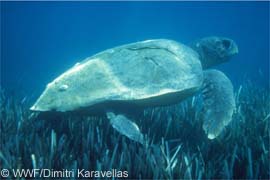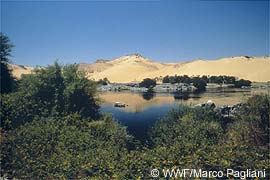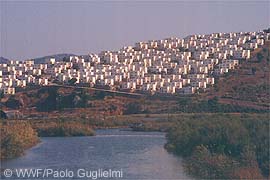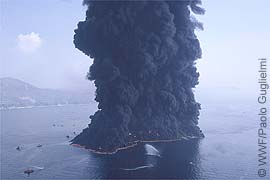 |
|
|
 |
||
|
|
|
THE MEDITERRANEAN: FOUR THORNY ISSUES Claudia Giammatteo
|
|||||
| Wars of water Beyond any consideration of the effect on water shortage on human health and on deeply degraded wetland habitats, the scarcity of water is already creating tension between some states within the region. The main reason is that the freshwater resources of some countries originate in neighbouring countries, leading to conflicts of rights regarding control and management of these resources. International disputes over water control have been raised in Turkey, Syria and Iraq to some extent, and in the Middle East.
|
|
||||
| Where does the blame lie? Some of the reasons for the depletion of water resources are simple to understand: population growth – particularly in the southern and eastern basin – and the spread of economic activity on an industrial scale have led to a dramatic increase in the demand for freshwater. Meanwhile, the rapid spread of urbanisation has changed the patterns of consumption, while the need to increase the area of productive land has caused greater demand for irrigation. Another "key" factor is deforestation. Forests act like vast sponges, retaining water and gradually releasing it into freshwater ecosystems. Take the forest away, and that water is going to be wasted. Then, there are the effects of climate change. Weather patterns are becoming more erratic, with drought in some places matched by severe flooding in others. As a result, there is no water where it is needed and too much where it is not. Without any reduction of CO2 emissions, annual rainfall is projected to decline by 10 to 40% over much of Africa and south-eastern Spain by 2100. (Data source: Greenpeace) |
|||||
| The agriculture factor 82%: the percentage of freshwater taken by agriculture in southern Europe. (Data source: WWF) According to a WWF survey, farming practises encouraged by the EU Common Agricultural Policy have lead to the over-exploitation of natural resources, the destruction of wildlife, and the contamination of freshwater and marine ecosystems by pesticides, phosphates, and nitrates. For example, nitrate concentrations now exceed EU guidelines in more than 85% of agricultural land in Europe. Farming in the Mediterranean varies greatly. At one extreme, there are highly industrial systems which rely on external inputs and capital equipment and which function in a largely artificial environment. As demand for irrigation water increases, the over-extraction of groundwater, already a problem in the most arid areas, will likely worsen. This in turn can lead to salinisation which ultimately renders the land unusable, thus jeopardising the sustainable use of this natural resource. |
|
||||
| 2. Population pressure In 1990, 82 million people lived on the Mediterranean coast. In 2025 there will be 150 million. |
|||||
Trends in urbanisation, energy consumption, agriculture, waste disposal and industry show disturbing intensification of environmental degradation and pollution of the coastal areas, despite significant advances in legislation at the level of the European Union, the Barcelona Convention and legislation throughout the region. Excessive concentration of development and unplanned urbanisation along the coast have overwhelmed the capacity to control municipal sewage or solid waste generation and disposal. Convenient industrial siting near coastal areas occurs with inadequate controls on industrial wastewater and hazardous discharges; tourist establishments on sandy beaches and other coastal areas do not consider the ecological functions of marine and coastal resources, such as sand dunes, posidonia beds, river estuaries or coastal lagoons. In the southern Mediterranean, demographic pressure is causing the degradation and disappearance of natural forest areas due to clearing for cropland, overgrazing and demand for fuelwood. The production of energy and the transportation of goods and services have a serious impact on the Mediterranean region. The burning of fossil fuels also contributes to the rise of greenhouse gases and the associated risks of climate change. The transportation sector has an impact on the environment of sea and land. In the sea, the main environmental hazards are routine oil releases and the illegal disposal of waste. On land, road building is associated with considerable destruction of rural areas and disturbance of flora and fauna: roads lead to growth of urbanisation and cause erosion and landslides in mountainous areas. |
|||||
The tourism factor According to experts, the main conservation issue facing the Mediterranean coast over the next 20 years is tourism. Over 100 million tourists flock to Mediterranean beaches every year and this number is expected to double by 2025. In order to cater for this booming business, natural habitats have been replaced by modern resorts; breeding and nesting sites (notably of the endangered loggerhead sea turtles) have been destroyed to accommodate tourist facilities and the extra pollution generated is often dumped untreated into the sea, threatening the entire eco-equilibrium of the region. The main consequences of tourism on the environment can be summarised as two main effects: excessive use of resources (land, water, energy, etc) and pollution (solid waste, noise, air emissions). Companies involved in the tourist industry have responded to concern about the environmental and the social impact of tourism by introducing self-regulatory measures. Most of them have started to recognise that environmental policies are not only beneficial to business but essential to its long term economic survival. But another threat is putting the world’s tourist industry at risk: global warming, which threatens to raise the temperature in Mediterranean resorts to unbearable levels and turn Alpine ski slopes to mush.
According to a report released by WWF’s Climate Change Campaign, droughts, rising seas, flash floods, forest fires and diseases could turn profitable tourist destinations into holiday horror stories. More frequent periods of extreme heat will cause discomfort in many eastern Mediterranean resorts, where the number of days above 40° C is expected to increase. While beach resorts may still be bearable, cities such as Athens could become decidedly uncomfortable. Smog will continue to be a big problem, not only in Greece but elsewhere in the eastern Mediterranean. Other detrimental consequences could include further water supply restrictions and forest fires. In addition, climate change is expected to increase the risk of illness, leading to a falling-off of tourism. A rising tide of malaria and cholera could spread through the Mediterranean basin in the near future, putting at risk previously unaffected areas. Ironically, the tourism industry is not just a potential victim of global warming, it also contributes to the causes of climate change. Air travel is reported as the fastest growing source of greenhouse emissions and therefore increases the risk of continued global warming. |
|||||
| 3. Forest loss & degradation Almost 85% of Mediterranean forests have already disappeared. |
|||||
| From the remaining, still extensive, oldgrowth temperate forests of Turkey and the Balkans in the North, down to the very fragmented and small relic forest patches in the Middle East and Northern Africa, many habitats and species are in danger. It is estimated that only 17 per cent of the region's original forest cover still exists. Many of the remaining forests are relics, and very few valuable Mediterranean forests have been protected. No single Mediterranean country has a representative system of protected areas. The major threats to forests are fragmentation, road construction, tourism, atmospheric pollution, climate change, unnatural forest fires, overgrazing, hunting, extraction and mining of mineral resources, drainage, water regulation and even war. War has both a direct and an indirect impact on nature as well as on human populations. Bombs and arson set off forest fires, and political instability encourages logging of protected areas. In general, a substantial amount of deforestation in the Mediterranean region is due to fire. An estimated total of 1 % of the regional forest cover is reported to be engulfed by flames every year, resulting in widescale atmospheric pollution. Fires are often set off intentionally in response to conflicts over land, which are mostly related to construction and tourism. Sometimes, fire is used as a means of protest against political decisions or conservation plans. Whatever physical form the threats to the forests' existence take, the long history of widespread forest devastation and exploitation is leading to critical levels of deforestation, erosion and risks of desertification. Timber collection for building and fuel, clear cutting for grazing and agriculture, fires, and the abandonment of mountain land have all taken their toll on the region’s forests. Most of today’s human activities continue to reduce forest resources, especially at lower altitudes. Tourism in coastal areas puts pressure on forests which are either cleared for development or deliberately burnt: fires are also caused by unregulated waste disposal in or near forests, and the general depopulation of rural areas allows fires to develop unchecked. Portugal, Spain and Turkey have all suffered from widespread afforestation projects with exotic species such as eucalyptus, which have replaced indigenous trees, causing problems of erosion. Agricultural expansion in lowland areas replaces both coniferous and mixed forests in the Maghreb, Turkey, Syria and Cyprus. Forests also suffer from natural diseases and pests, made specially vulnerable during long periods of drought. Evidence of long range atmospheric transport of pollutants affecting forests and their soil has been noted in Italy and Greece. Forests in trouble WWF has identified the 300 most important and representative forest areas that lack adequate protection in the Mediterranean region. These are the top 10 "hot spots": Croatia: Velebit WWF has two targets: the establishment of an ecologically representative network of protected areas incorporating at least 10% of each of the world forest types by the end of the year 2005; the independent certification of at least 25 million hectares of managed forest by June 2001 with special emphasis on the major timber producing countries. |
|
||||
|
|||||
|
|||||
|
4. Sea pollution |
|||||
| The Mediterranean marine and coastal environment is under pressure from a wide range of sources. One quarter of the pollution is created at sea by activities such as dredging, drilling for oil and minerals, and shipping (see box). Three-quarters of the pollution is estimated to originate from land-based sources, such as industry and urban waste, causing contamination of seafood and eutrophication of enclosed bays. Raw sewage and fertilisers both contain nutrients such as nitrogen and phosphorus, which create a massive explosion of toxic algae. Algae-poisoned seafood is responsible for many human illnesses, including neurological disorders, cardiovascular diseases, and gastrointestinal problems. Industrial processes release harmful chemicals (chlorine compounds are particularly dangerous) which end up in the sea, poisoning marine animals and plants. These toxic chemicals accumulate in food chains, through bioaccumulation. Big fish eat thousands of small ones resulting in a concentration of poisons in larger fish. These fish may in turn be eaten by other fish or by mammals, and the poison gets passed on. Agricultural pesticides seep through the soil and into rivers which then wash them out to sea. Pesticides like Tributyltin (TBT) used to prevent boats from becoming encrusted with shellfish, are highly toxic. In 1970, TBT caused French oysters to develop deformed shells and become sterile. Contaminants also enter the sea from atmospheric deposition and through water exchange, primarily with the Atlantic Ocean and Black Sea. As the Mediterranean is almost entirely landlocked, its waters have a very low renewal rate which explains why they are so sensitive to pollution. Because of the high evaporation rates, they are not even fully replenished by rainfall and river flows. |
|
||||
|
|||||
| The top 10 polluted areas Elevated concentrations of mercury, cadmium, zinc and lead in sediments are found in various "hot spots", areas within the Mediterranean basin where a high release of pollutants has been verified. In 1997, during the 10th Barcelona Convention in Tunis, 119 "hot spots" were identified. The 10 top renowned areas are: Iskenderun Bay (Turkey); Izmir Bay (Turkey); Thermaikos Gulf (Greece); Patraikos Gulf (Greece); the Po Delta (Italy); Rhone Delta (France); the Ebro Delta (Spain); the Bay of Tunis (Tunis); the Nile Delta (Egypt); Haifa Bay (Israel). |
|||||
 The Sea turtle (Caretta caretta) is one of the most endangered species in the Mediterranean. Destruction of nesting sites, unintentional killing and human consumption are the main threats. |
|||||
Copyright © text 2000 WWF. All rights reserved.



